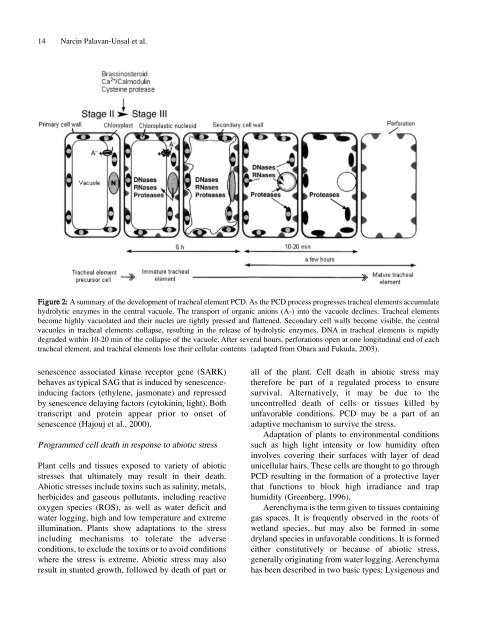Full Journal - Journal of Cell and Molecular Biology - Haliç Üniversitesi
Full Journal - Journal of Cell and Molecular Biology - Haliç Üniversitesi
Full Journal - Journal of Cell and Molecular Biology - Haliç Üniversitesi
Create successful ePaper yourself
Turn your PDF publications into a flip-book with our unique Google optimized e-Paper software.
14 Narcin Palavan-Unsal et al.<br />
Figure 2: A summary <strong>of</strong> the development <strong>of</strong> tracheal element PCD. As the PCD process progresses tracheal elements accumulate<br />
hydrolytic enzymes in the central vacuole. The transport <strong>of</strong> organic anions (A-) into the vacuole declines. Tracheal elements<br />
become highly vacuolated <strong>and</strong> their nuclei are tightly pressed <strong>and</strong> flattened. Secondary cell walls become visible, the central<br />
vacuoles in tracheal elements collapse, resulting in the release <strong>of</strong> hydrolytic enzymes. DNA in tracheal elements is rapidly<br />
degraded within 10-20 min <strong>of</strong> the collapse <strong>of</strong> the vacuole. After several hours, perforations open at one longitudinal end <strong>of</strong> each<br />
tracheal element, <strong>and</strong> tracheal elements lose their cellular contents (adapted from Obara <strong>and</strong> Fukuda, 2003).<br />
senescence associated kinase receptor gene (SARK)<br />
behaves as typical SAG that is induced by senescenceinducing<br />
factors (ethylene, jasmonate) <strong>and</strong> repressed<br />
by senescence delaying factors (cytokinin, light). Both<br />
transcript <strong>and</strong> protein appear prior to onset <strong>of</strong><br />
senescence (Hajouj et al., 2000).<br />
Programmed cell death in response to abiotic stress<br />
Plant cells <strong>and</strong> tissues exposed to variety <strong>of</strong> abiotic<br />
stresses that ultimately may result in their death.<br />
Abiotic stresses include toxins such as salinity, metals,<br />
herbicides <strong>and</strong> gaseous pollutants, including reactive<br />
oxygen species (ROS), as well as water deficit <strong>and</strong><br />
water logging, high <strong>and</strong> low temperature <strong>and</strong> extreme<br />
illumination. Plants show adaptations to the stress<br />
including mechanisms to tolerate the adverse<br />
conditions, to exclude the toxins or to avoid conditions<br />
where the stress is extreme. Abiotic stress may also<br />
result in stunted growth, followed by death <strong>of</strong> part or<br />
all <strong>of</strong> the plant. <strong>Cell</strong> death in abiotic stress may<br />
therefore be part <strong>of</strong> a regulated process to ensure<br />
survival. Alternatively, it may be due to the<br />
uncontrolled death <strong>of</strong> cells or tissues killed by<br />
unfavorable conditions. PCD may be a part <strong>of</strong> an<br />
adaptive mechanism to survive the stress.<br />
Adaptation <strong>of</strong> plants to environmental conditions<br />
such as high light intensity or low humidity <strong>of</strong>ten<br />
involves covering their surfaces with layer <strong>of</strong> dead<br />
unicellular hairs. These cells are thought to go through<br />
PCD resulting in the formation <strong>of</strong> a protective layer<br />
that functions to block high irradiance <strong>and</strong> trap<br />
humidity (Greenberg, 1996).<br />
Aerenchyma is the term given to tissues containing<br />
gas spaces. It is frequently observed in the roots <strong>of</strong><br />
wetl<strong>and</strong> species, but may also be formed in some<br />
dryl<strong>and</strong> species in unfavorable conditions. It is formed<br />
either constitutively or because <strong>of</strong> abiotic stress,<br />
generally originating from water logging. Aerenchyma<br />
has been described in two basic types: Lysigenous <strong>and</strong>

















